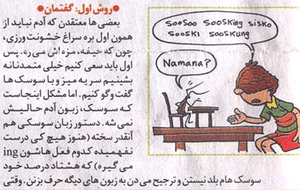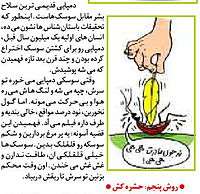Iran newspaper cockroach cartoon controversy


The cockroach cartoon controversy of Iran newspaper arose over a cartoon, published in the Iranian holiday-magazine of Iran-e-jomee, drawn by the cartoonist Mana Neyestani, an ethnic Iranian Azeri.[1][2][3][4] The cartoon, published in the children's section of the newspaper on 12 May 2006, allegedly insulted the Azerbaijani people by depicting a child and cockroach speaking in Persian together. In the cartoon when the cockroach does not understand the child, he then decides to talk to the cockroach in an imaginary cockroach language (saying "soosoo soosking sisko sooski sooskung"). But the cockroach does not even understand its own language and replies by saying "namana?" ("what?"). Namana is a word which originates in the Azerbaijani language, but is sometimes used in the Persian-speaking population, too. In other sections of the cartoon, the cockroach goes back to speaking in Persian again (the second picture).[5]
Contents of the article
The article which the cartoons accompany is entitled "How to stop the cockroaches from making us into cockroaches?" It is a satirical article in a children's weekly newspaper. The text of the paragraph in image 1 is translated as follows:
| “ | "First method: dialogue" Some people believe that one should not resort to violence as an initial step, because that will just take all the fun out of the process. So we must first try to come to the table like civilized people and have a dialogue with the cockroaches. But the problem is that a cockroach cannot understand human language [i.e., reasoned argument]. And cockroach grammar is so difficult—nobody has yet discovered which of their verbs end in "ing"--that 80% of the cockroaches themselves do not know it and prefer to speak in other languages. When even the cockroaches do not understand their own language, how could you possibly understand it?! This is precisely why negotiations hit a dead-end and the sweet methodology of violence becomes a necessity! |
” |
The article's use of the key words "dialogue" (گفتمان) and "violence" (خشونت ورزی), plus discussions about problems understanding the language of the "cockroaches," can be interpreted as tacit references to the reformist's nomenclature in contrast to the language of the conservatives in Iran. The famous reformist motto "dialogue between civilizations", used by Iran's former president Mohammad Khatami, was a source of criticism among the intelligentsia, because they questioned how it could be possible to have such a dialogue between Iran and the western civilizations when it was not even possible to have a dialogue and mutual understanding between reformist and conservative Iranians.
In the cartoon, a child is speaking in "cockroach language" to a cockroach, but the cockroach replies "namana?" ("what?"). Namana is originally an Azeri word, but is also used in Persian. In other sections of the cartoon, the cockroach speaks in Persian. Following the publication of the piece, some Azeris found it insulting. They objected to the depiction of the cockroach as speaking Azeri and the insinuation that the Azeri-speaking cockroach "cannot understand human language."
Aftermath
The controversy resulted in massive riots throughout Iran in May 2006, most notably in the predominantly Azerbaijani-populated cities of Tabriz, Urmia, Ardabil, Zanjan and Naghadeh and number of smaller towns. The riots were violent in some cases, with protesters damaging public buildings and throwing stones, prompting the reaction of the Iranian police.[6] Such riots had occurred before in recent years in many Persian and non-Persian cities of Iran as well as Tehran, Mashhad, Arak, Shiraz, Qazvin, Isfahan, Sabzevar, Ahvaz, and Zahidan. In the current case, the violence clearly had ethnic components, but the far greater causes of the poverty and unemployment that vexes members of Azeri ethnic groups, are government corruption, inefficiency, and a general sense of lawlessness, which all Iranians, including Persians, must confront. Amnesty International claims that "hundreds, if not thousands, were arrested and scores reportedly killed by the security forces,"[7] while the Iranian authorities say 330 people were arrested during the protests, and four demonstrators were killed.[8]
The Iranian government promptly responded to the events by temporarily shutting down the Iran newspaper, arresting the cartoonist and the editor-in-chief of the newspaper, Mehrdad Ghasemfar. It further accused "outside forces in playing the nationalistic card".[9]
Possible foreign interference
Emad Afrough, head of the Majlis Cultural Commission at the time, said that pan-Turkists were involved in creating the tensions.[10] Other members of the Iranian government blamed it on the United States, Israel, and the United Kingdom, suspecting the incitement of ethnic strife in Iran. It was alleged that the United States is conducting covert operations in Iran and is allied with Iran's neighbor, the Republic of Azerbaijan.[11]
Abbas Maleki, a senior research fellow at Harvard University and a former Iran's deputy foreign minister, stated:[11]
I think that when President Bush says all options are on the table, the destabilization of Iran's ethnic provinces is one of them. Don't forget, Mr Mahmudali Chehregani, one of the pan-Turkist leaders agitating for a separatist Azeri agenda, was in Washington last year by invitation of the Defense Department.
Reuel Marc Gerecht, a former CIA operative, had stated in the early 1990s:[11]
Accessible through Turkey and ex-Soviet Azerbaijan, eyed already by nationalists in Baku, more westward-looking than most [of] Iran, and economically going nowhere, Iran's richest agricultural province was an ideal CIA [covert action] theater.
According to Touraj Atabaki, well-known expert on Iranian Azeris, there might be some truth behind the Iranian government's allegations of a foreign plot, yet the responsibility for the unrest lies first and foremost with the central government.[12] Similarly, Iason Athanasiadis in an article in Asia Time Online mentioned that "there is no hard evidence pointing toward the troubles as being anything but domestic".[11]
Cartoonist's apology
Later, Mana Neyestani wrote a letter to the head of Tabriz cartoonists and explained that using the Azeri expressions like "Namana" (what?) and "Sanana" (That is none of your business) in ordinary Persian is very frequent and shows the influence of Azeri Turkish in Persian language and using such expressions did not mean any insult to Azeri Turks. He also said he has many Azeri friends and had no purpose and no reason to insult them.[13]
References
- ↑ "Cockroach Cartoonist Jailed In Iran". The Comics Reporter. 24 May 2006.
- ↑ "Iranian paper banned over cartoon". BBC News. 23 May 2006.
- ↑ "IFJ Criticises "Political Interference" as Cartoons Rows Put Journalists in Jail in Iran and Jordan". International Federation of Journalists. 3 June 2006.
- ↑ "Azeris are unhappy at being the butt of national jokes". IRIN. United Nations Office for the Coordination of Humanitarian Affairs (OCHA). 15 May 2006.
- ↑ Suskhaava Panturkisthaa
- ↑ Iran Focus
- ↑ Amnesty International. Iran, Annual Report, 2007
- ↑ Iran Says 330 Arrested Over Recent Cartoon Unrest Refl
- ↑ Daria Vaisman. "The other cartoon protests: Large demonstrations broke out across Iran in May 2006 to protest a cartoon insulting to Azeris", The Christian Science Monitor, 22 May 2007.
- ↑ Iran-daily
- 1 2 3 4 Asia Times Online
- ↑ Iran: Cartoon protests signal Azeri frustration
- ↑ Iran newspaper cartoonist explained... Sharifnews (in Persian)
